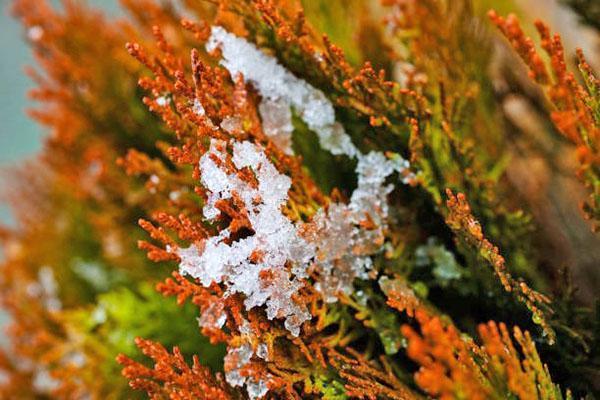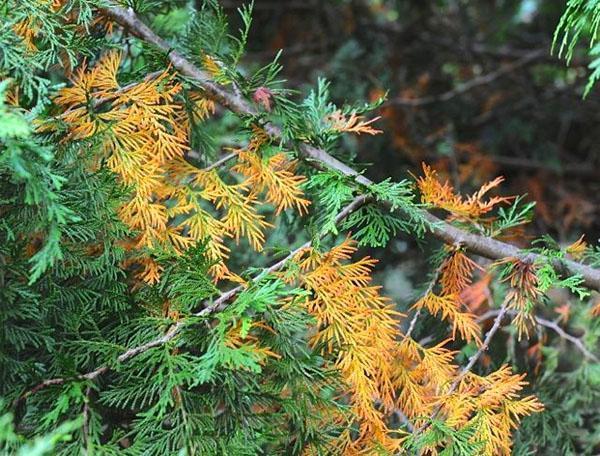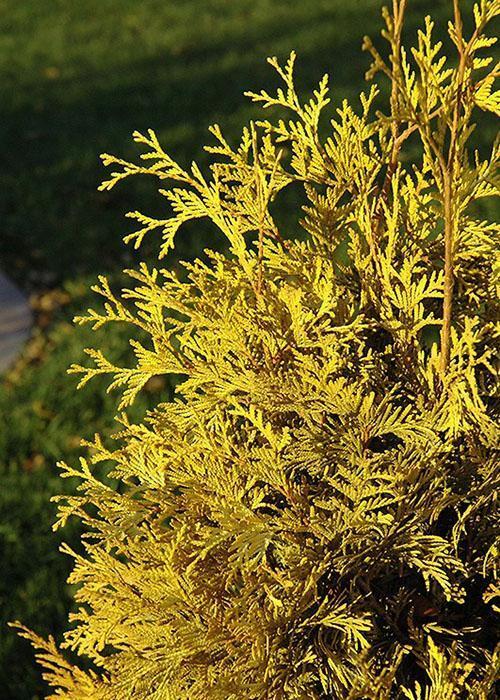How to solve the problem when your favorite thuja turned yellow after winter
 Going to the site in early spring, the summer resident expects to see signs of the awakening of nature and the fresh needles of evergreen crops, but sometimes he will be disappointed. Why did the thuja turn yellow after winter, what to do in a similar situation? How to restore beauty to a plant?
Going to the site in early spring, the summer resident expects to see signs of the awakening of nature and the fresh needles of evergreen crops, but sometimes he will be disappointed. Why did the thuja turn yellow after winter, what to do in a similar situation? How to restore beauty to a plant?
Needles can change their color for many reasons. Therefore, during the inspection of the thuja, you need to pay attention not only to the unnatural color, but also to the condition of the ephedra.
If the needles are alive, but have changed their color to golden or bronze, or yellowing has affected only a small part of the branches inside the crown, it is possible thuja will recover without human intervention. And the reason for yellowing is the natural processes of renewal of needles and changes in its color with the change of seasons. But what to do in the spring if the thuja has turned yellow, its shoots have a depressed appearance, and the needles have lost their elasticity, have become fragile, dry?
Massive browning, yellowness and death of greenery in large areas are a reason to sound the alarm and take serious measures to save the plant.
Natural causes of yellowing of thuja

In this case, the yellowing of the thuja goes from the trunk and skeletal branches to the outer part of the crown, it is hardly noticeable and is never massive.
 Many species and varieties of thuja for the winter, although they do not lose needles, change their color to golden, reddish-copper, bronze, brown. Thuja Smaragd is practically the only exception, which remains emerald green even in the most severe climatic conditions.
Many species and varieties of thuja for the winter, although they do not lose needles, change their color to golden, reddish-copper, bronze, brown. Thuja Smaragd is practically the only exception, which remains emerald green even in the most severe climatic conditions.
If the thuja has turned yellow for natural reasons, no special measures are taken. With the arrival of heat, the plant will wake up and regain its attractive appearance, and easy sanitary pruning and introduction will help it nitrogen fertilizers.
Why did thuja turn yellow after winter: care errors
 The most common reason for the yellowness and necrosis of needles in spring is sunburn, which is not terrible for a limited number of species. To protect the plant, until the crown is completely thawed, the crown is loosely, leaving air access, covered with non-woven material.
The most common reason for the yellowness and necrosis of needles in spring is sunburn, which is not terrible for a limited number of species. To protect the plant, until the crown is completely thawed, the crown is loosely, leaving air access, covered with non-woven material.
In regions with harsh, especially snowless winters, and also a long spring, accompanied by thaws and severe frosts, thuja at this time needs additional protection, which will protect not only from the needles burns that worsen the decorative effect, but also from frost cracks that affect the bark and wood of the trunk and skeletal branches.
What to do if the thuja turns yellow after winter and has noticeably dried out even with proper cover?
Experienced gardeners consider insufficient autumn-spring watering as a common reason for changing the color of needles.
Left without moisture in the fall, the ephedra left in the winter poorly prepared, and with the arrival of heat it is difficult for it to immediately grow. You can return this beauty:
- having adjusted the irrigation regime, while observing in order not to overflow the evergreen culture;
- by pruning damaged branches;
- feeding the shrub with a spring mixture of fertilizers for conifers.
An extra dose of nitrogen fertilizer and a shearing will help plants that are planted as a living wall or curb along a track, footpath or in an area where they walk pets... Although thuja are very persistent, and they can suffer from exposure to:
- reagents designed to accelerate the melting of snow and ice;
- from intensive exhaust of cars and aggressive compounds and salts of heavy metals getting into the soil with melt water;
- from systematic feces and marks of cats and dogs.
 Care errors can be corrected, but what if the thuja turned yellow soon after planting?
Care errors can be corrected, but what if the thuja turned yellow soon after planting?
What to do when thuja turns yellow after planting
 Shrubs planted in the fall can become covered with unsightly brown and yellow spots in the first spring. What happens to the plant and how can you help it?
Shrubs planted in the fall can become covered with unsightly brown and yellow spots in the first spring. What happens to the plant and how can you help it?
The most likely reason for the yellowing of thuja in the first year of life in the open field is considered to be incorrect planting.
Novice gardeners do not take into account that conifers are very negative about:
- to the proximity of groundwater, the stagnation of which causes rotting of the root system, yellowing of the needles and drying out of the branches;
- to deepening or exposure of the root collar, which leads to growth inhibition, the risk of stem rot at the base of the stem;
- too frequent planting of single plants, which provokes contact of branches, disturbance of their growth, drying out and falling of needles;
- to improperly selected, too dense, poor or water-saturated soil.
 Unfortunately, if these mistakes are made, it is better to transplant, providing the plant with everything necessary for growth, including drainage, a distance of at least a meter from the nearest neighbors and a soil consisting of sod land with the addition of sand and low-lying peat.
Unfortunately, if these mistakes are made, it is better to transplant, providing the plant with everything necessary for growth, including drainage, a distance of at least a meter from the nearest neighbors and a soil consisting of sod land with the addition of sand and low-lying peat.
Yellowing of thuja from pests and diseases

Conifers, like other garden plants, are susceptible to bacterial and fungal diseases. Their traces can be seen both in summer and spring.
Thuja turned yellow after winter, what to do, and how to identify the enemy with whom you have to fight?
After the snow melts, especially on young shrubs, symptoms of the multiplication of harmful fungi, parasitizing not only on the surface, but also inside the tissues, can be found. Spreading in a dense crown, they cause a change in the color of the needles, drying out of the first thin, and then the main shoots. In addition to microscopic fungi, plants are harmed by tinder fungi and all kinds of rot.
As a prophylaxis of wilting and necrosis, thuja is sprayed with Bordeaux liquid or other fungicides containing copper in spring and before winter. In the risk zone, the treatment is repeated in the summer.
Spraying is carried out after sanitary pruning and sanitation of all damage left in winter:
- cracks in the bark;
- frostbite;
- cuts of large branches.
If there are dead, old or heavily rotted or fungal plants on the site, they are removed, and the stumps are uprooted and burned.
Along with pathogens, dangerous sucking insects can settle on thuja, causing yellowing of the needles and the death of individual parts of the plant. A careful study of the crown and infected areas will help to identify enemies. And to get rid of them will help systemic insecticides, which are used both for medicinal purposes and for prevention.